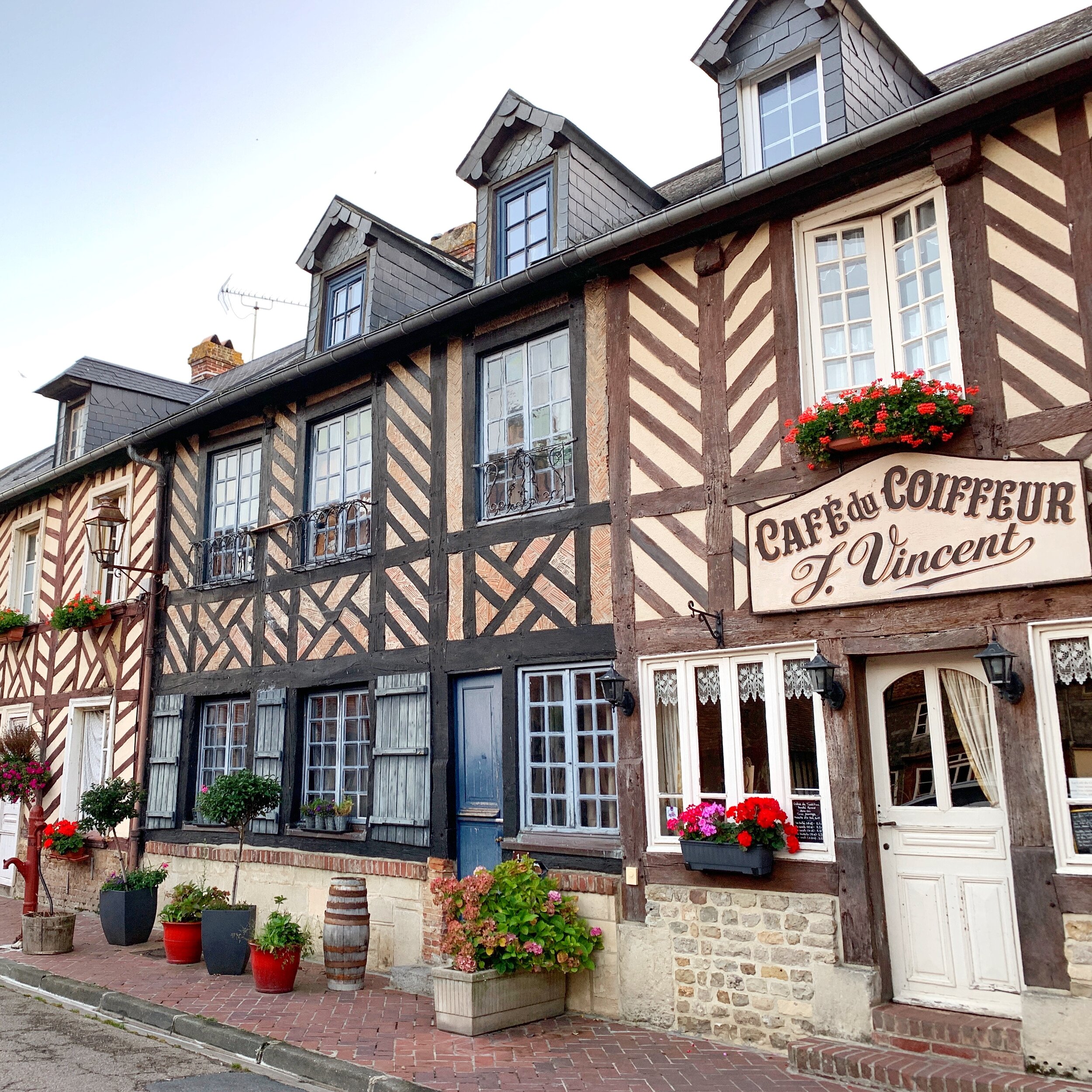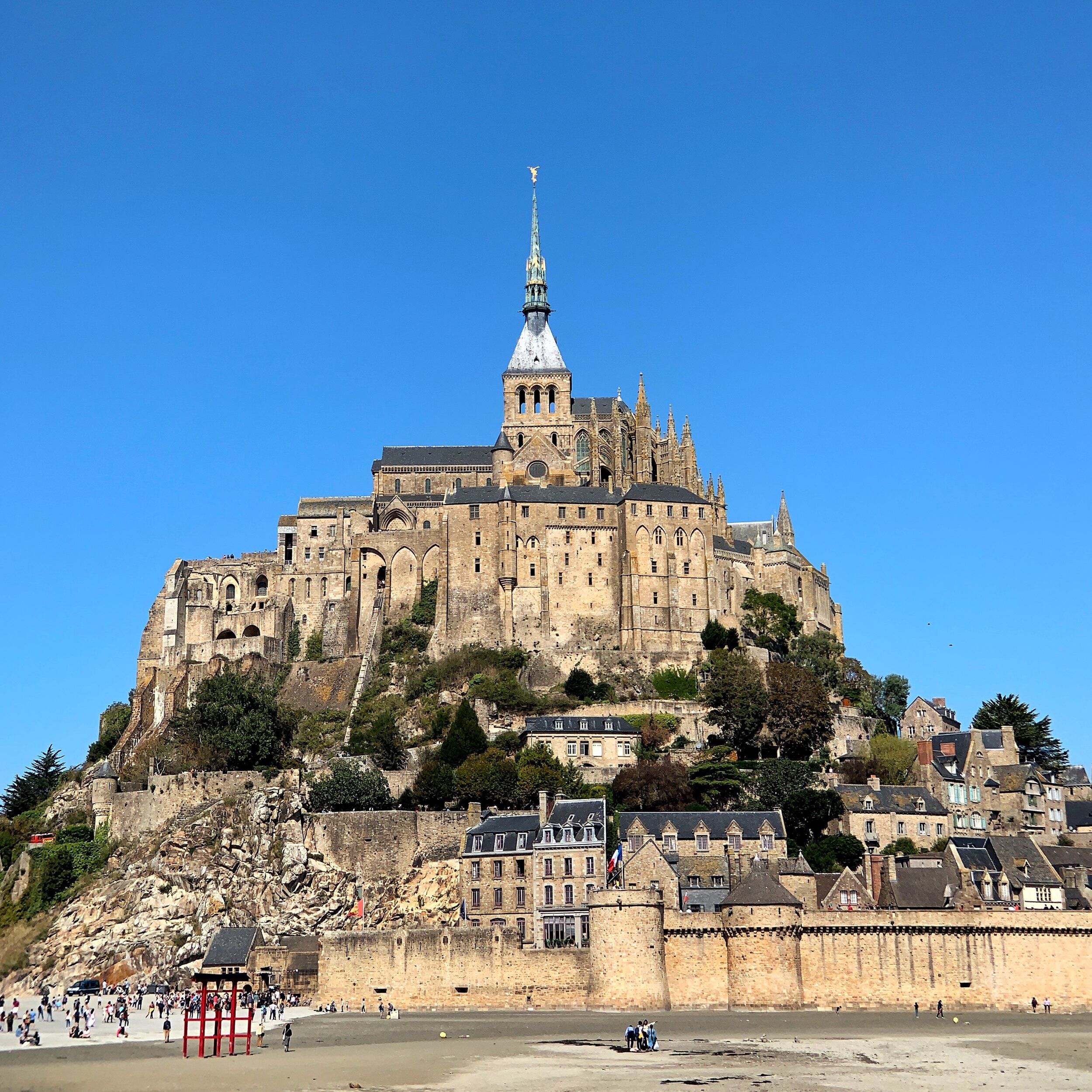Nous Voyageons de Ville en Ville
Normandie
Notre vie c'est le vent du large
L'odeur du pain, le goût du vin
Le soleil pâle des matins
Le soleil noir des soirs d'orage
I’ve spent a lot of time in France, but had somehow never been to Normandie before. I say “somehow,” but the truth is that my parents are among those French people who swear off Normandie, claiming it’s always rainy, and preferring to go to the South. So while I knew of Normandie as the land of rich butter and delicious camembert, the home of calvados and brut cidre, I didn’t know what to expect beyond the iconic image of Mont Saint Michel. A perusal of English language guidebooks indicated a bevy of WWII sites which certainly didn’t prepare me for the land of charming small towns and well-preserved Norman architecture, or the lovely beachfront promenades which reminded me of the southern coast of the UK. I was least of all prepared for the summery weather.
I always think sunny visits to otherwise rainy places are traps—like stunt weather to make you think that would be a nice place to live. While wandering Seattle in a tank top last summer, I could imagine a happy life there. I might feel differently come February. These few days in Normandie were similar: who wouldn’t want to live in this beautiful region with its near-empty beaches and affordable historic villas? I’m told the winters are dreary, but for now Normandie lives on in my memory with the sun shining on gently rolling hills of bright green grass and some of the prettiest cows I’ve ever seen.
When I announced the dates I wanted to be in Paris to visit my parents, my dad told me that my stepmother had a gathering in Cabourg while I was there, giving us an excuse to visit Mont Saint Michel while she would be occupied with her Proust society colleagues.
Cabourg and neighboring Houlgate are perfectly picturesque Norman towns on the coast of La Manche (or the English Channel if you prefer). They feel like the set of a French Wes Anderson film—particularly the Grand Hotel in Cabourg where Marcel Proust spent summers (hence the meeting of the Proust enthusiasts and the images of Marcel everywhere you go). The area is a testament to the benefits of historic preservation—apart from the seafront where some charmless modern monstrosities have managed to sneak past the arbiters of good taste.
The north of France looks different from other regions. For one thing, you can drive all day and not pass any vineyards. Instead of grapes, they grow apples, and instead of wine, you get cidre and calvados. We visited one of the larger calvados distillers, Chateau du Breuil, which is family owned, but feels a bit like the Coppola winery of calvados. The setting is beautiful, but the product is...just ok. Still, it’s fun to see a brandy distillery in action.
My father often chooses travel destinations by the availability of a Michelin 1-star restaurant. He sees 2-star ratings as a sign of the restaurant’s ascent or decline—a transitional state rather than a real rating, and 3-star restaurants are both too much of a production and too expensive for him. In this case, he’d found Le Pavé d’Auge which was in the still more picturesque town of Beuvron-en-Auge, about 30 minutes away. The food was as expected, but the service and “extras” signaled a restaurant hoping to get that second star the next time the Michelin reviewers come through.
The following morning we left my stepmother to her “Prousting” and headed east to Normandie’s biggest tourist draw: le Mont Saint Michel. The drive took us past still more shiny Jersey cows and eventually the little black-faced sheep who graze on the salty grass near the coast (to eventually become l’agneau pré-salé—pre-salted lamb. What will they think of next?). As scenic as the drive was, nothing quite prepares you for the first glimpse of Mont Saint Michel which appears quite suddenly and looks like an illustration from a fantasy book of yore.
Mont Saint Michel is a tidal island—depending on where in the tidal cycle you visit, it may be an island, surrounded by the glassy water of its bay, but much of the time, it rises directly out of the smooth sand, 15km from the water’s edge. While I would have loved to see the abbey reflected in the water, I found the alien landscape of the sand and tidal pools mesmerizing.
Mont Saint Michel receives somewhere around three million visitors a year. All things considered, they’ve done a pretty good job of managing the crowds (large and well marked parking lots, frequent and free shuttle buses that carry the hordes to the island across a newly-built bridge. But even in the off-season, there’s a crush of people around the shuttle buses and on the island. Any hopes of a quiet moment of reflection are quickly dashed, but they’re replaced by marvel at the height and scale of what people built here long before modern machinery or electricity.
Once we pass through the gates, the road up to the abbey is crowded with tourists, pilgrims, and souvenir shops, but if I can tune out the clutter, it looks something like Diagon Alley. Pushing past the crowds, we found a creperie up a small flight of stairs at the back of a shop—offering a moment of respite to enjoy the earthy buckwheat galettes. By the time we left, they had a sign up that said “complet (full).” Refueled, we continued the climb up, up, up to the ramparts and eventually to the abbey itself.
Inside, we joined a tour group with a highly entertaining French guide who spoke with a heavy Norman accent and a heavy lisp. He explained that Mont Saint Michel had once belonged to Brittany, but the river that was the demarcation between Brittany and Normandie moved over the last 1000 years, the site became part of Normandie. In each room of the tour, he would ask where we were. The correct answer each time was “Nor-Man-Die.”
The abbey has a number of highlights including lovely cloisters, but personally I found the exteriors and the views out from the island to be the best parts.
Fatigued by the crowds even more than the climb, we headed back toward Paris. To break up the drive, my dad had picked a town for us to stay overnight. Mayenne is nothing special (truly), but they have a 1-star restaurant, so there we posted up for the night. In contrast with the previous night’s dinner, this one had abysmal service and really interesting food. Not that you ever need to stop in Mayenne.
Upon returning to Paris, I learned that two good friends are moving to Normandie—to Dieppe. I can’t wait to explore the region more once they’re settled. Hopefully in late summer when the sun is out.
Side note: being on the coast of France reminded me of two of my favorite French films, both by Jacques Demy.
You might recognize the fellow in orange as Bernardo from West Side Story.
















